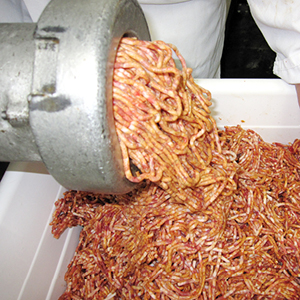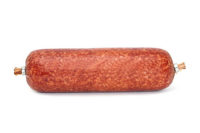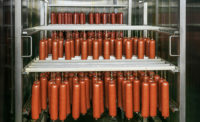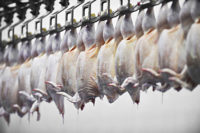
|
Grinders and stuffers also have to deal with the changing raw materials that processors see, not only from lot to lot that comes into a plant, but also the changes in raw materials that processors see over time, says Jeff Sindelar, assistant professor and extension meat specialist at the University of Wisconsin, Madison, Wis.
In regard to grinding, the challenges have always been consistent particle definition and minimizing meat temperature rise, says Lynn Knipe, associate professor at The Ohio State University, Columbus, Ohio.
“Rough cutting and overworking of the meat will cause the fat to smear under the casing during stuffing, which is a visual defect as well, but can also impede moisture loss from sausage during drying,” he says.
With stuffing, the challenges are removing air from the mixture, obtaining accurate product portions at higher volume output and the previously mentioned avoidance of fat smearing on the surface of the product under the casing, Knipe says.
Greater grinding
For ground-beef processor AFA Foods, Fort Worth, Texas, grinding and the production of raw ground beef require appropriate grinding equipment that is well-maintained with the proper tooling, says Tim Biela, executive vice president of food safety and quality assurance at the company.
“Grinding can have a tremendous impact on the condition of raw ground beef being ground and additionally to the condition of the finished product being produced,” Biela explains.
The condition of raw materials coming into the grinding operation can and do vary from day to day, week to week and at various times during the year.
“Ground-beef processors typically use a least cost formulation approach, so the percentage of each type raw materials used on any given day will vary relative to the percent fresh lean or fat or the percentages of various frozen components,” Biela explains. “Given these variables, it is imperative to perform routine preventive maintenance on all grinding equipment, regularly.
“Additionally, the tooling — cutting knives and inserts, grinding plates and augers — must be maintained and must be ‘fit’ for use, depending on the type product you are manufacturing,” he continues. “Daily sharpening of all grind plates with installation of new cutting blades or inserts is essential. Dull blades and cutting knives will impact the condition of the finished product while placing a strain on the equipment, which can lead to motor failure or wear on key components of the grinders.”
Proper maintenance of the grinding equipment can enhance the quality of the finished product, optimize the shelf life of the finished product, and enhance the color and appearance of the finished product, which, in turn, will enhance the opportunity for consumer satisfaction and increase sales, Biela adds.
Self-sharpening knives for grinders also have allowed for improved particle definition, reduced smearing and fat cell damage, Knipe says. In addition, grinders that use a piston system to push the meat to the knives and plates will maintain particle integrity and minimize temperature rise in the product by not overworking the product. Plus, with a piston system, available in [some] in-line grinders, the blade is sitting on the back side of the plate, which works the product less and gives the cleanest separation of the meat particles, Knipe says.
The makeup of the grinder system doesn’t allow for many new technologies, but the ability to do a continuous fat analysis, typically near infrared interactance (NIR), is one advancement, Sindelar says. Technology also has allowed grinders to adjust auger speeds of different sets of augers, such as feeder and processing augers.
“One of the advancements that we’ve seen is the ability to adjust the speeds of those independently, so that we are having more of a cutting versus a tearing action in product that is being put into a hopper,” Sindelar says. “So then by doing this, we can see improvements in particle definition and less fine particles that occur because of shattering.”
Better grinder knife and plate heads are being developed as well, so that the frequency of having to sharpen is sometimes less, he says. The development of multiple knife/plate setups also has allowed processors to do more than one grind in a single pass, which has aided in efficiencies, Sindelar says.
Stepping up stuffing
Stuffing technology has improved to allow for reduced product damage and less smearing of the fat under the casing, as well as high-volume production while maintaining accurate portion sizes.
“Of course, meat temperature is an important factor in reducing fat smear, but the type of pump can also have an effect on meat particle damage and fat smear,” Knipe says. “Pumps that minimize the mechanical action on the meat, such as piston stuffers, minimize the damage to the fat and cause less smearing of the fat under the casing.”
Portioning from the pump has been developed on a lot of stuffers, which reduces the need for a separate portioning device, hence, reducing equipment costs, he adds. “Stuffers with vane pumps are typically the most accurate in meat portioning,” Knipe says.
Along with in-line grinding now being incorporated into processing of more products, which makes processing more efficient, Sindelar also agrees that more systems and attachments are being coupled with stuffers. For example, meatball and hamburger formers have been synchronized with stuffers to create more efficient systems, he says.
The ability to pull a good vacuum during stuffing is very important to product appearance, shelf life and casing use.
“Removing more air pockets and voids from products allows for a more anaerobic environment in a vacuum package and a longer shelf life to the cured color as oxidation is minimized and bacterial growth is minimized,” Knipe says.
A vacuumized piston stuffer works best for removing unwanted air from ground and whole-muscle products. However, one supplier now offers a dual vacuum system, which has greatly improved the ability to pull a higher vacuum on meat going through a vane pump, Knipe says.
Along with these other advancements, grinding and stuffing equipment providers have done a good job of designing functional equipment that have improved ability for sanitation, Sindelar adds.





Report Abusive Comment